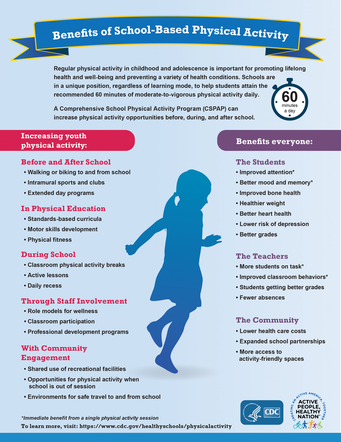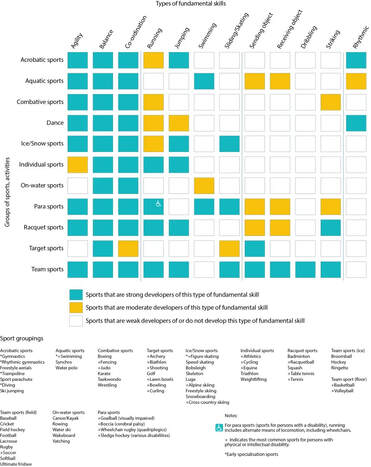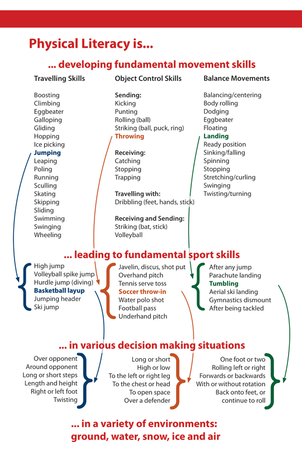Importance of Physical Education
|
Of the many subjects children study in school, there may be none more important than physical education. However it must be of high quality and aligned with state/national standards and guidelines. A high quality physical education program offers children opportunities to develop the skills, concepts, and dispositions needed to be physically active for life. Sufficient, regular physical activity not only helps prevent major diseases but it also: promotes learning; reduces stress, anxiety, and depression; and improves overall student wellness. It doesn’t matter if the child excels in every other subject in school and grows up to become a successful professional, with poor health any professional achievement becomes secondary.
There are many factors that contribute to the ease of implementing and sustaining a quality program, including the involvement of the administration, parents, and community. However it ultimately comes down to the willingness of the physical education teacher(s) to do their best no matter the situation. That being said, REAL teachers still need our support and appreciation. This can be in the form of equipment (every jump-rope, pedometer, heart-rate monitor, and home-made scoop catcher counts), classroom assistance, time and funding for professional development, and by advocating for quality physical education at the local and state/national levels. |
Current inactivity pandemic
Cost of Physical Inactivity
- Health and Economic Value of Eliminating Socioeconomic Disparities in US Youth Physical Activity
- Modeling The Economic And Health Impact Of Increasing Children’s Physical Activity In The United States
- The Cost of Physical Inactivity: Moving Into the 21st Century
- The Economic Burden of Physical Inactivity: A Global Analysis of Major Non-Communicable Diseases
- Who Highlights High Cost of Physical Inactivity in First-Ever Global Report
- Why Should People be Active? (CDC)
Student Obesity and Physical Activity Levels
- Nutrition, Physical Activity and Obesity: Data, Trends, and Maps (CDC)
- Obesity Rates & Trends (TheStateOfObesity)
- 2023 - Game Changer: A Plan to Transform Young Lives Through Sport (Centre for Social Justice)
- 2023 - International Olympic Committee Trends in Youth Sport
- 2022 - Global Status Report on Physical Activity (WHO)
- 2022 - Worldwide Physical Activity Trends Since COVID-19 Onset
- 2021 - State of Play 2021 (Aspen Institute)
- 2020 - Longitudinal Trends in BMI Before and During the COVID-19 Pandemic Among Persons Aged 2–19 Years (CDC)
- 2020 - Overview Report on US Participation (Physical Activity Council)
- 2019 - Global Trends in Insufficient Physical Activity Among Adolescents (WHO)
- 2018 - United States Report Card on Physical Activity for Children and Youth (National Physical Activity Plan)
School Policies
- Physical Education and Physical Activity Policies in School
- 2024 - Quality Physical Education Policies and Practice the Global State of Play (UNESCO)
- 2023 - State of Obesity: Better Policies for a Healthier America
- 2023 - The International Framework for School Health Promotion: Supporting Young People Through and After the COVID-19 Pandemic
- 2022 - School Health Profiles Questions: United States (CDC)
- 2021 - Quality Physical Education Policy Project (UNESCO)
- 2019 - Status of State-Level PE Accountability Policy and Systems (ActiveSchools)
- 2019 - The Movement Disparity: Parent and Principal Perspectives on Physical Activity in Schools (ActiveSchools)
- 2016 - School Health Policies and Practices Study 2016 (CDC)
- 2016 - Shape of the Nation Report (SHAPE America)
- 2012 - Physical Education Profiles (CDC)
Trouble with Military Recruitment
CAMPAIGNS TO INCREASE OPPORTUNITIES FOR PHYSICAL ACTIVITY
|
Comprehensive School Physical Activity Program (CSPAP): "Schools play a vital role in ensuring children and adolescents get the nationally recommended 60 minutes of physical activity each day...A CSPAP is a multi-component approach by which school districts and schools use all opportunities for students to be physically active, meet the nationally-recommended 60 minutes of physical activity each day, and develop the knowledge, skills, and confidence to be physically active for a lifetime. A CSPAP reflects strong coordination and synergy across all of the components: physical education as the foundation; physical activity before, during, and after school; staff involvement; and family and community engagement."
|
Guidelines and Toolkits
- Active Equipment Library Program (supportREALteachers)
- Active Schools Guiding Framework (Active Schools)
- Active Schools Evaluation Handbook (Active Schools)
- Importance of Recess, Play, and Active Classrooms (supportREALteachers)
- Physical Education and Physical Activity (CDC)
- Promoting Physical Activity Through Schools - Toolkit (WHO)
- Promoting Physical Activity Through Schools - Policy Brief (WHO)
Online Campaigns
- Active Schools: Join a network of parents, schools, and partner organizations who are changing the way we prioritize physical activity in schools. It means making connections.
- Coalition for Quality Physical Education: Our program that invites individuals, private industry, and non-profit groups to join us in our mission
- Every Kid Sports Pass: Provides youth sports grants to kids from income-restricted families.
- Voice for Healthy Kids: Supports advocacy campaigns, creates visibility for issues that affect children's health, mobilizes communities, helps to advance science and research via communications and messaging expertise, and fosters partnerships.




